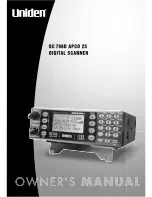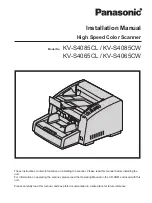
SCIENTIFIC TECHNOLOGIES INC.
R
14
Section 7 – Array Modifying Commands
7
Array Modifying Commands
These commands modify the scanner’s
beam pattern to 1) improve the resolution, 2)
ignore small objects, and 3) alter how the
scanner interprets the beam status. If these are
not needed in your application skip to the next
section.
N
ORMAL
S
CAN
AND
D
OUBLE
S
CAN
F
UNCTIONS
Description: ValuScan has two scanning
modes: normal scan and DoubleScan.
DoubleScan can provide improved resolution in
some applications but it doubles the scan time.
Syntax:
NORMAL
or
DOUBLE
Action:
NORMAL
turns off DoubleScan and
turns on normal scan.
DOUBLE
turns off normal
scan and turns on DoubleScan.
S
CREEN
F
UNCTION
Description: The screen function sets a
minimum value the scanner will report. It can
be used to filter out small objects.
Exceptions:
RELAY BLOCK
and serial
functions
ASCII RAW
and
BINARY RAW
are not
affected by this function.
Command Syntax:
SCREEN x
where values of
x
or smaller are ignored.
Example:
SCREEN 10
will ignore objects that
block 10 beams or fewer.
M
ASKING
F
UNCTION
Mask allows you to manipulate the status of
the beams before the scanner interprets and
reports them. This is commonly used to invert
the status of the beams to report holes in a
material, or to ignore specific beams that are
blocked by a stationary object. Two commands
are used for masking: one sets a mask pattern,
and the other defines masking logic. The
scanner always uses masking. The default
settings, however, result in the real beam status.
SETMSK
SETMSK (set mask) is used to set the mask
pattern.
Syntax:
SETMSK hh hh hh hh ...
where
hh
represents two hexadecimal characters (0
through 9, A, B, C, D, E, and F). A space must
immediately follow “SETMSK”. The
hexadecimal characters must be given in pairs
with a space between pairs. Each hexadecimal
character represents 4 beams (see chart). “0”
represents an unblocked beam and “1”
represents a blocked beam.
To set a beam pattern, write a binary code
using one bit for each beam. Use “1” for a
blocked beam and “0” for an unblocked beam.
(The left most bit represents the beam farthest
from the cable.) Group this pattern into sets of 4
bits. Convert each set into one hexadecimal
character using the chart at the right. Type
SETMSK
followed by a space, followed by the
hexadecimal character string. (Remember to
type a space between each pair of hexadecimal
characters.)
Hex
Beams
0
0 0 0 0
1
0 0 0 1
2
0 0 1 0
3
0 0 1 1
4
0 1 0 0
5
0 1 0 1
6
0 1 1 0
7
0 1 1 1
8
1 0 0 0
9
1 0 0 1






































